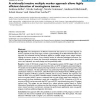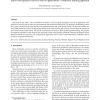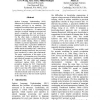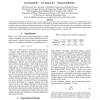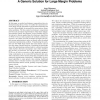114
Voted
JMLR
2010
14 years 7 months ago
2010
The problem of characterizing learnability is the most basic question of statistical learning theory. A fundamental and long-standing answer, at least for the case of supervised c...
111
click to vote
BMCBI
2011
14 years 7 months ago
2011
Background: When investigating covariate interactions and group associations with standard regression analyses, the relationship between the response variable and exposure may be ...
120
click to vote
BMCBI
2006
2006
A minimally invasive multiple marker approach allows highly efficient detection of meningioma tumors
15 years 12 days ago
Background: The development of effective frameworks that permit an accurate diagnosis of tumors, especially in their early stages, remains a grand challenge in the field of bioinf...
105
click to vote
CSL
2008
Springer
15 years 12 days ago
2008
Springer
Active learning (AL) is a framework that attempts to reduce the cost of annotating training material for statistical learning methods. While a lot of papers have been presented on...
CN
2010
15 years 13 days ago
2010
The focus of this work is on the estimation of quality of service (QoS) parameters seen by an application. Our proposal is based on end-to-end active measurements and statistical ...
120
click to vote
BMCBI
2008
15 years 14 days ago
2008
Background: Probability based statistical learning methods such as mutual information and Bayesian networks have emerged as a major category of tools for reverse engineering mecha...
121
click to vote
AAAI
2000
15 years 1 months ago
2000
Due to the large variation and richness of visual inputs, statistical learning gets more and more concerned in the practice of visual processing such as visual tracking and recogn...
130
Voted
ACL
2006
15 years 1 months ago
2006
Spoken Language Understanding (SLU) addresses the problem of extracting semantic meaning conveyed in an utterance. The traditional knowledge-based approach to this problem is very...
105
click to vote
LREC
2010
15 years 1 months ago
2010
We investigate the impact of input data scale in corpus-based learning using a study style of Zipf's law. In our research, Chinese word segmentation is chosen as the study ca...
133
click to vote
GECCO
2006
Springer
15 years 4 months ago
2006
Springer
In this paper we embed evolutionary computation into statistical learning theory. First, we outline the connection between large margin optimization and statistical learning and s...


